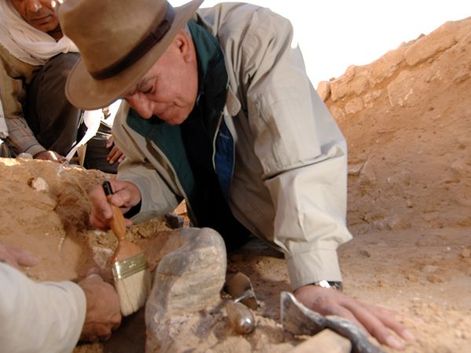 Zawi Hawas
Zawi Hawas My professor believed her to be buried near her palace with Mark Antony, in a tomb that had long been lost beneath the depths of the ocean. My professor’s answer, however, was only an educated guess.
He did not know where Cleopatra was buried, and this uncertainty only fueled the mounting flame of my curiosity. I used to visit the location that people thought was her palace and conjure her in my mind, marveling at how little we knew about Egypt’s last queen and how much remained to be discovered.
After graduating from the university, my interest in Cleopatra waned until, in 2004, Kathleen Martinez, a Dominican scholar of Greek and Roman history, explained her theory about Cleopatra. She described her as a philosopher and linguist, and a shrewd politician—a woman to be reckoned with. Kathleen was certain that Cleopatra and Mark Antony were buried together inside the temple of Taposiris Magna, a site located 45 kilometers [28 miles] west of Alexandria, far from the submerged tomb my professor had described. According to Kathleen, this temple represented the dwelling of the god Osiris, which possessed a profound meaning for Cleopatra, who frequently portrayed herself as the human representation of the goddess Isis, wife of Osiris. Mark Antony, Cleopatra’s lover leading up to her death, was often seen as the human manifestation of Osiris. Thus the temple of Taposiris may have held a deeply sentimental importance for this queen, who lost Antony just before Egypt fell to the Romans.
Kathleen had searched for Cleopatra’s tomb in other temples by carefully analyzing a wealth of architectural, archaeological, and iconographical evidence as well as the symbolism, chronology, and mythology surrounding these temples. The only possible burial place that embodied all the symbolism of divinity and religious ritual, while simultaneously conveying Cleopatra’s personal legacy, was Taposiris Magna.
Many have searched for the tomb of Alexander the Great, but no one had searched for that missing piece of ancient Egypt’s story—the tomb of Cleopatra, who took her own life rather than surrender her homeland to the Romans. This bright young scholar rekindled my old passion for the story of Cleopatra. It occurred to me that we had before us an opportunity to recover the last page in that the book of ancient Egyptian civilization, an opportunity we could not pass by. And so Kathleen and myself, together with an Egyptian archaeological team, began the search for Cleopatra’s tomb in hopes of removing some of the great mystery that hangs thick around this famous queen.
from: http://www.nationalgeographic.com/events/cleopatra/zahi-hawass/
 RSS Feed
RSS Feed